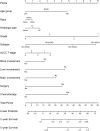Clinical outcomes and a nomogram for de novo metastatic breast cancer with lung metastasis: a population-based study
- PMID: 35246585
- PMCID: PMC8897413
- DOI: 10.1038/s41598-022-07565-x
Clinical outcomes and a nomogram for de novo metastatic breast cancer with lung metastasis: a population-based study
Abstract
To better understand the clinical characteristics of newly diagnosed lung metastatic breast cancer (LMBC) and quantify its prognosis, we retrieved data on patients with LMBC from the Surveillance, Epidemiology, and End Results database. Eligible patients were randomly assigned to training and validation cohorts (ratio 7:3) to establish a nomogram using the Cox proportional hazards regression model. In total, 4310 patients with LMBC were enrolled, including 52.4% (2259/4310) HR+/HER2-, 17.6% (757/4310) HR+/HER2+, 10.8% (467/4310) HR-/HER2+, and 19.2% (827/4310) HR-/HER2- subtype patients. Inclinations of lung and brain involvement in HR-/HER2+ and HR-/HER2- subgroups, liver involvement in the HER2 overexpressing subgroup, and bone involvement in the HR-positive subgroup were detected in the LMBC population. Regarding prognosis, HR+/HER2+ subtype patients presented the most favorable profile (mOS 35.0 months, 95% CI 30.1-39.9), while HR-/HER2- patients exhibited the worst (mOS 11.0 months, 95% CI, 10.0-11.9). A nomogram was developed in the training cohort and validated internally (C-index 0.70) and externally (C-index 0.71), suggestive of decent performance. This study assessed the clinical outcomes associated with molecular subtypes, metastatic patterns, and surgical intervention and provided a robust nomogram for the estimation of survival probabilities, which are promising for the management of LMBC in clinical practice.
© 2022. The Author(s).
Conflict of interest statement
The authors declare no competing interests.
Figures



Similar articles
-
Clinical features of patients with HER2-positive breast cancer and development of a nomogram for predicting survival.ESMO Open. 2021 Aug;6(4):100232. doi: 10.1016/j.esmoop.2021.100232. Epub 2021 Aug 13. ESMO Open. 2021. PMID: 34392135 Free PMC article.
-
De novo metastasis in breast cancer: occurrence and overall survival stratified by molecular subtype.Clin Exp Metastasis. 2017 Dec;34(8):457-465. doi: 10.1007/s10585-017-9871-9. Epub 2017 Dec 29. Clin Exp Metastasis. 2017. PMID: 29288366
-
Clinicopathological characteristics and prognosis of microinvasive breast cancer: A population-based analysis.Cancer Med. 2022 Dec;11(23):4501-4512. doi: 10.1002/cam4.4839. Epub 2022 May 22. Cancer Med. 2022. PMID: 35598300 Free PMC article. Clinical Trial.
-
Prognostic nomogram for patients with non-metastatic HER2 positive breast cancer in a prospective cohort.Int J Biol Markers. 2019 Mar;34(1):41-46. doi: 10.1177/1724600818824786. Epub 2019 Mar 11. Int J Biol Markers. 2019. PMID: 30852974
-
The impact of hormone receptor on the clinical outcomes of HER2-positive breast cancer: a population-based study.Int J Clin Oncol. 2022 Apr;27(4):707-716. doi: 10.1007/s10147-022-02115-x. Epub 2022 Jan 18. Int J Clin Oncol. 2022. PMID: 35041101 Free PMC article.
Cited by
-
Prognostic factors analysis and nomogram construction of breast cancer patients lung metastases and bone metastases.Surg Open Sci. 2025 Apr 23;26:28-38. doi: 10.1016/j.sopen.2025.04.006. eCollection 2025 Jun. Surg Open Sci. 2025. PMID: 40385973 Free PMC article.
-
Prognostic analysis of breast cancer in Xinjiang based on Cox proportional hazards model and two-step cluster method.Front Oncol. 2023 Jan 17;12:1044945. doi: 10.3389/fonc.2022.1044945. eCollection 2022. Front Oncol. 2023. PMID: 36733362 Free PMC article.
-
Anti-migratory Properties of Cryoprotective Isoliquiritigenin-zein Phosphatidylcholine Nanoparticles Prevent Triple-negative Breast Cancer through PI3K-mTOR and MMP2/9 Pathways.Curr Med Chem. 2025;32(9):1770-1788. doi: 10.2174/0109298673259973231023110945. Curr Med Chem. 2025. PMID: 37936460
-
Exploring IgSF11 as a potential immune checkpoint and immunotherapeutic target in breast cancer.Cancer Immunol Immunother. 2025 Aug 14;74(9):288. doi: 10.1007/s00262-025-04095-z. Cancer Immunol Immunother. 2025. PMID: 40810781 Free PMC article.
-
Heterogeneous tissue-specific macrophages orchestrate metastatic organotropism of breast cancer: implications for promising therapeutics.J Transl Med. 2025 Jun 20;23(1):692. doi: 10.1186/s12967-025-06660-7. J Transl Med. 2025. PMID: 40542349 Free PMC article. Review.
References
Publication types
MeSH terms
Substances
LinkOut - more resources
Full Text Sources
Medical
Research Materials
Miscellaneous

